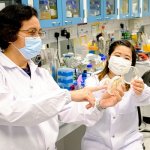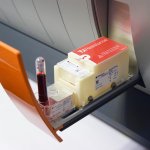
News • MRSA, E.Coli & co
New compound kills antibiotic resistant superbugs
Researchers at the University of Sheffield have developed a new compound that is able to kill both gram-positive and gram-negative antibiotic-resistant bacteria.

Researchers at the University of Sheffield have developed a new compound that is able to kill both gram-positive and gram-negative antibiotic-resistant bacteria.

In order to combat bacterial wound infections, Empa researchers have developed cellulose membranes equipped with antimicrobial peptides. Initial results show: The skin-friendly membranes made of plant-based materials kill bacteria very efficiently. If germs invade a wound, they can trigger a long-lasting infection that may fail to heal or even spread throughout the body, leading to…

Scientists at Nanyang Technological University, Singapore (NTU Singapore) have developed a synthetic peptide that can make multidrug-resistant bacteria sensitive to antibiotics again when used together with traditional antibiotics, offering hope for the prospect of a combination treatment strategy to tackle certain antibiotic-tolerant infections.

Antibiotic resistance is an increasing battle for scientists to overcome, as more antimicrobials are urgently needed to treat biofilm-associated infections. However, scientists from the School of Life Sciences at the University of Warwick say research into natural antimicrobials could provide candidates to fill the antibiotic discovery gap.

Resistance to antibiotics has become a serious public health problem. Hospital infections, prostheses or surgical implants that become infected and do not respond to treatment are a real challenge to the research community, which has been seeking alternatives for effectively eliminating these bacteria for years. In 2012 the researchers from the Department of Chemical Engineering of the…

University of Melbourne researchers are finding ways to beat dangerous superbugs with ‘resistance resistant’ antibiotics, and it could help in the fight against coronavirus (COVID-19) complications. As bacteria evolve, they develop strategies that undermine antibiotics and morph into ‘superbugs’ that can resist most available treatments and cause potentially lethal infections. The…

A probiotic drink could become a promising new weapon in the battle against antibiotic resistant bacteria, after a team of scientists at the University of Birmingham engineered and patented a key genetic element that can tackle the genetic basis of resistance. The team is now seeking funding for a clinical trial for the drink which has potential to work against many resistant bacteria commonly…

Researchers at Lund University in Sweden have developed a new hydrogel based on the body’s natural peptide defense. It has been shown to prevent and treat infections in wounds. The formulation kills multi-resistant bacteria, something that is increasing in importance with antibiotic resistance growing globally. “The ability to effectively heal wounds is key for our survival in evolutionary…

A common first-line treatment approach for cryptococcal meningitis in low-income countries is being compromised by the emergence of drug resistance, new University of Liverpool research warns. Published in the journal mBio, the findings highlight the need to develop new drugs and treatment regimens for the lethal brain infection, which kills around 180,000 people each year. Cryptococcal…

Research led by scientists from McMaster University has yielded a potent antimicrobial that works against the toughest infectious disease strains. The find could be the beginning of developing new therapeutics to combat drug-resistant infections. The discovery is important as it is directly related to the development of Staphylococcus aureus diseases, known popularly as staph infections, which…

T2 Biosystems, Inc., a leader in the development and commercialization of medical diagnostic products, and CARB-X, a global non-profit partnership dedicated to accelerating R&D innovation to address the rising global threat of drug-resistant bacteria, announced the granting of a CE mark to the T2Resistance Panel. With the CE mark, T2 Biosystems has met the requirements of the In-Vitro…

Antibiotic-resistant pathogens pose one of the greatest threats to public health worldwide. In the near future, harmless bacterial infections may no longer be treatable and may again become the most common non-natural cause of death. At the same time, the available repertoire of antibacterial agents is becoming increasingly smaller as resistance rates rise.

Nosocomial infections cause more deaths than traffic accidents – a stunning discovery made in a recent German study. Worse: infectious diseases long thought eradicated in Europe, such as measles, tuberculosis (TB) and, more recently, syphilis, are also implicated. The increasing number of patients places an additional financial burden on healthcare. But – and this might be the good news –…

PHE’s latest English Surveillance Programme for Antimicrobial Utilisation and Resistance (ESPAUR) report shows that there were an estimated 61,000 antibiotic resistant infections in England during 2018, a 9 percent rise from 2017.[i]

Scientists from Scotland are developing a low cost, rapid diagnostic sensor test which aims to show the susceptibility of bacteria to antibiotics within 45 minutes. Laboratory testing of samples can take up to two days and the new test aims to allow doctors to be able to prescribe the correct antibiotic to a patient for an infection more quickly. In a research paper published in the journal…

Many life-threatening bacteria are becoming increasingly resistant to existing antibiotics. Swiss researchers co-headed by the University of Zurich have now discovered a new class of antibiotics with a unique spectrum of activity and mechanism of action. By disrupting outer membrane synthesis, the antibiotics effectively kill Gram-negative bacteria. According to the World Health Organization…

Scientists have uncovered a novel antibiotic-free approach that could help prevent and treat one of the most widespread bacterial pathogens, using nanocapsules made of natural ingredients. Helicobacter pylori is a bacterial pathogen carried by 4.4 billion people worldwide, with the highest prevalence in Africa, Latin America and the Caribbean. Although the majority of infections show no symptoms,…

Antibiotics are still the most important weapon for combatting bacterial infections. But medical science is running out of “ammunition” because of more and more frequently occurring resistances. A research team has now elucidated the structure of the proteolytic complex ClpX-ClpP. This is a key to development of innovative antibiotics which target the degradation process of defective proteins…

Scientists at the University of Surrey have discovered that a natural antioxidant commonly found in green tea can help eliminate antibiotic resistant bacteria...

T2 Biosystems and CARB-X announced that the T2Resistance Panel is the first diagnostic to graduate from CARB-X’s portfolio.

Bacteria are becoming increasingly resistant to common antibiotics. Often, resistance is mediated by resistance genes, which can simply jump from one bacterial population to the next. It’s a common assumption that the resistance genes spread primarily when antibiotics are used, a rationale backed up by Darwin's theory: only in cases where antibiotics are actually being used does a resistant…

Cigarette smoke can make MRSA bacterial strains more resistant to antibiotics, new research from the University of Bath has shown. In addition cigarette smoke exposure can make some strains of Staphylococcus aureus – a microbe present in 30-60% of the global population and responsible for many diseases, some fatal – more invasive and persistent, although the effect is not universal across all…

New research has found that antibiotic-resistant strains of Klebsiella pneumoniae, an opportunistic pathogen that can cause respiratory and bloodstream infections, are spreading through hospitals in Europe. Certain strains are resistant to the carbapenem antibiotics that represent the last line of defence in treating infections and are therefore regarded as extremely drug resistant (XDR).

Global warming may have played a pivotal role in the emergence of Candida auris. According to a new study published in mBio, an open-access journal of the American Society for Microbiology, C. auris, which is often multi-drug resistant and is a serious public health threat, may be the first example of a new fungal disease emerging from climate change.

In view of the increase of multidrug-resistant organisms (MDRO), the WHO has declared antibiotic resistance one of the biggest threats to global health. MDROs have become a major problem particularly in hospitals. Professor Dr Georg Häcker from the Institute for Microbiology and Hygiene at the University Hospital Freiburg, explains some strategies to prevent hospital-acquired infections (HAIs).